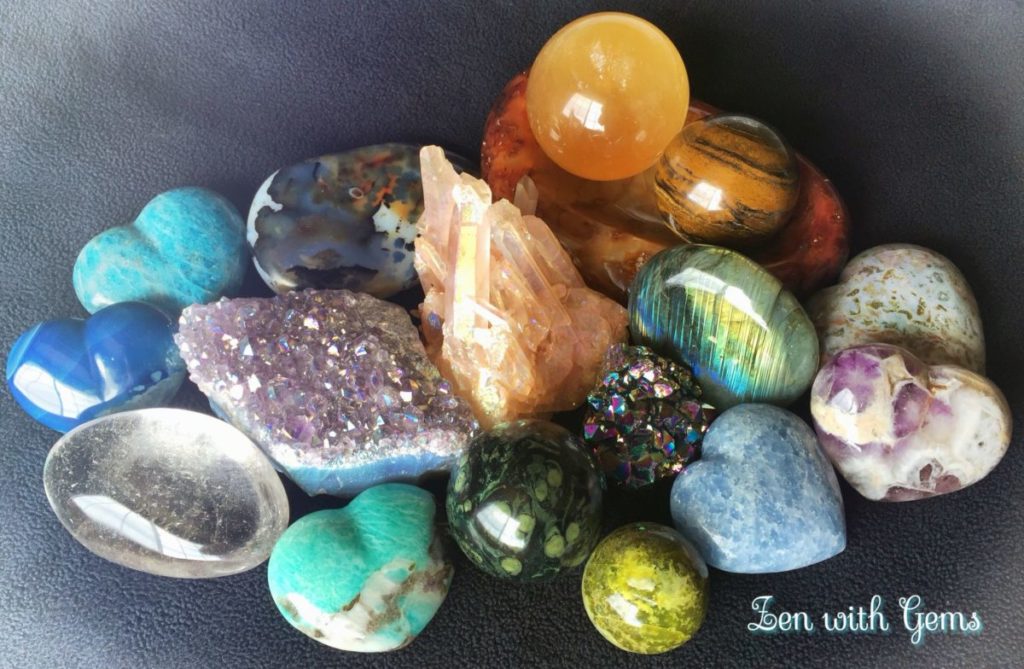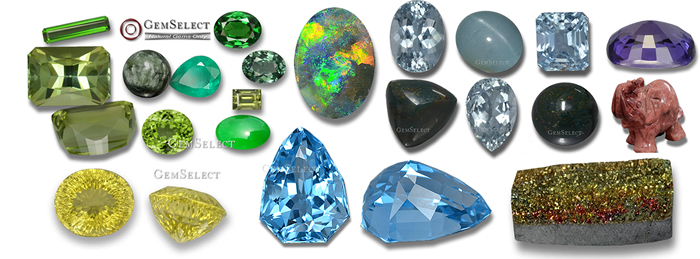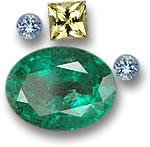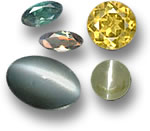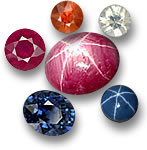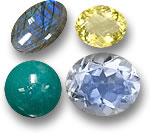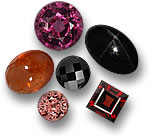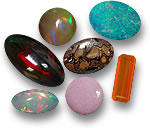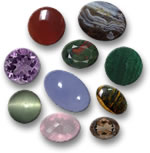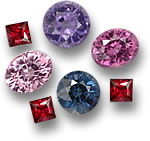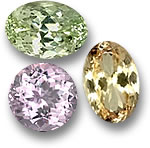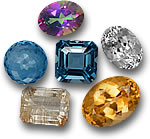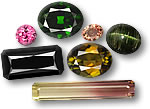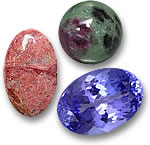Today, there are over 130 different varieties of precious and semi-precious gemstones available. Many of the different gemstone types belong to a larger common family or umbrella group of related gems.
In many cases, gemstone groups are based on physical properties, such as water content or optical phenomena, for example, cat’s eye gemstones, rutilated gemstones, star gemstones, and color change gemstones. Other gemstone groups may be based on more unusual criteria such as organic gemstones, natural glass gemstones, mineraloid or non-crystalline gemstones, and even gemstones that are just rocks. Interestingly, there are even gemstone groups that are not actually ‘groups’ at all, but rather just a single species; but because of their significance in the gem and jewelry trade, they are justifiably classed as their own group. Some single species gemstone groups include diamond, peridot, zircon, topaz, turquoise, and spinel.
The following is a brief summary of some of the most important gemstone groups today:
Hardness: 7.5 – 8 on the Mohs scale
Chemical Composition: Beryllium aluminum silicate
The beryl family is considered to be one of the most important of gemstone groups. The beryl group is most famous for emerald, a rich green chromium colored variety of precious beryl. In its purest form, beryl is completely colorless. The different varieties of gem-quality beryl are distinguished by their color and in some cases, their coloring agents. Although all beryl gemstones share a common chemical composition, they can vary significantly in transparency and clarity.
Varieties of beryl gemstones include:
| Aquamarine: | Light blue to greenish-blue beryl. |
| Bixbite: | Red Beryl. |
| Cat’s eye aquamarine: | Light-blue to greenish-blue beryl that exhibits chatoyancy. |
| Cat’s eye beryl: | Precious beryl that exhibits chatoyancy. |
| Emerald: | Green beryl colored by chromium (sometimes vanadium). |
| Goshenite: | Colorless to near-colorless beryl. |
| Green beryl: | Light-green beryl that lacks chromium as a coloring agent. |
| Morganite: | Pink beryl; colors can range from purplish-pink to peachy, or pinkish-orange to salmon. |
| Precious beryl or heliodor: | Yellow to golden to greenish-golden beryl. |
Hardness: 8.5 on the Mohs scale
Chemical Composition: Beryllium aluminum oxide
Chrysoberyl was first discovered in 1789 and since then, it has become one of the most important and valuable gemstone groups. It was formerly referred to as ‘chrysolite’, a historical name essentially describing any greenish-golden to an olive-colored gemstone. The chrysoberyl group is perhaps most famous for its cat’s eye gemstone variety, but the rarest and most valuable chrysoberyl is alexandrite – a highly desirable chromium-rich color-change variety of chrysoberyl.
Varieties of chrysoberyl gemstones include:
| Alexandrite: | A rare color-change variety of chrysoberyl that is red in incandescent light and green in daylight. |
| Cat’s eye alexandrite: | An extremely rare variety of color change chrysoberyl (alexandrite) that also exhibits chatoyancy. |
| Chrysoberyl: | The most common chrysoberyl that is highly transparent and typically yellowish-green to greenish-yellow in color. |
| Chrysoberyl cat’s eye: | Chrysoberyl that exhibits chatoyancy, a reflection of light reminiscent to the slit eye of a cat. |
Hardness: 9 on the Mohs scale
Chemical Composition: Aluminum oxide
The corundum gemstone group includes two of the most valuable and popular gemstones on the market today – sapphire and ruby. Corundum itself is not a very rare mineral, but fine crystalline forms of gemstone quality material are extremely rare. Next, to diamond, corundum is the second hardest material on earth. Although the corundum group is most famous for red ruby and blue sapphire, gem-quality corundum can occur in a wide variety of colors, including colorless, yellow, green, pink, and purple.
Varieties of corundum gemstones include:
| Color change sapphire: | A rare variety of sapphire that changes color under different types of light, such as daylight, incandescent light, or fluorescent light. |
| Ruby: | Any red, pink-red, or violet-red gem-quality form of corundum colored by chromium. |
| Star Ruby: | A variety of ruby that exhibits a rare star-like effect (asterism) when viewed under strong direct lighting. |
| Sapphire: | Any color of gem-quality corundum other than red. |
| Star sapphire: | A variety of sapphire that reflects a rare star-like effect (asterism) when viewed under strong direct lighting. |
Hardness: 6 – 6.5 on the Mohs scale
Composition: Aluminum silicates of sodium oxide, potassium oxide, or calcium oxide.
Feldspar is the most abundant mineral on earth, making up nearly 60% of the earth’s crust. The feldspar gemstone group is distinguished by composition and all feldspar gemstones are composed of aluminum and silicate ions. The feldspar group of gemstones is classified into two distinct primary branches: Plagioclase feldspar, which includes oligoclase, albite and andesine – and potassium feldspar, or alkali feldspar, which includes orthoclase or microcline.
Varieties of feldspar gemstones include:
| Amazonite: | A yellow-green to greenish-blue potassium feldspar of the microcline class. |
| Andesine-labradorite: | A variety of labradorite that is color enhanced through the process of lattice diffusion of copper-bearing agents. |
| Labradorite: | A gem-quality plagioclase feldspar prized for its metallic schiller and iridescence. |
| Moonstone: | A variety of gem-quality orthoclase that exhibits a remarkable sheen or adularescence |
| Orthoclase: | A transparent gem-quality form of potassium feldspar, usually yellow to golden in color. |
| Peristerite: | A variety of labradorite famed for its bluish-white sheen or adularescence. |
| Rainbow moonstone: | A variety of labradorite that exhibits a multicolored adularescence on light body color. |
| Spectrolite: | A variety of labradorite that exhibits the full spectrum of colors through its iridescence. |
| Sunstone: | A variety of gem-quality orthoclase or oligoclase feldspar famed for its glittery aventurescence. |
Hardness: 6.5 – 7.5 on the Mohs scale
Composition: A group of 6 primary silicate minerals
The garnets are one of the oldest and most important of colored gemstone groups. The garnet family is also one of the largest and most diverse groups, consisting of many different gemstone varieties. All garnet gemstones share a similar crystal structure and have similar though slightly varying chemical compositions. In gemology, there are six recognized primary species of the garnet based on chemical composition: Pyrope garnet, almandine garnet, spessartite garnet, grossularite garnet, uvarovite garnet, and andradite garnet.
Varieties of garnet gemstones include:
| Almandine garnet: | A gem-quality iron aluminum silicate garnet that occurs in various shades of red. |
| Andradite garnet: | A calcium iron silicate most famous for green demantoid garnet and black melanite garnet. |
| Grossularite garnet: | A calcium aluminum silicate most famous for chromium-rich green tsavorite. Pyrope garnet: A magnesium aluminum silicate often with a ruby-like red color, usually deeper in color than almandine. |
| Spessartite garnet: | A magnesium aluminum silicate usually orange to reddish-brown in color. Uvarovite garnet: An idiochromatic calcium chromium silicate desired for its emerald-like green color. |
Other trade names for sub-varieties and hybrid varieties of garnet gemstones include: Demantoid, melanite, topazolite, color-change garnet, hessonite garnet, hydrogrossular garnet, leuco garnet, Mali garnet, rhodolite garnet, umbalite garnet, star garnet, tsavorite garnet, chrome pyrope and malaya (malaia) garnet.
Hardness: 6 on the Mohs scale
Composition: Nephrite – Calcium magnesium silicate
Composition: Jadeite – Sodium aluminum silicate
The jade group of gemstones includes a handful of different gem types, many of which are technical ‘rocks’ composed of more than one mineral. The only two pure mineral forms of jade are jadeite and nephrite. Of the two pure forms of jade, jadeite is considered the rarer and more valuable type. Over the years, the term ‘jade’ has been used only in reference to jadeite or nephrite, but more recently, the name ‘jade’ has become an umbrella term used to describe a variety of gemstones that include varying amounts of jadeite, nephrite, albite, kosmochlor or omphacite. As a general rule of thumb, to be technically classified or marketed as a type of jade, materials should contain at least 20% to 80% jadeite, nephrite or both.
Varieties of jade gemstones include:
| Chloromelanite: | A type of jade composed of kosmochlor and jadeite, typically very dark-green to near-black in color. |
| Jadeite: | A gem-quality pyroxene mineral found in a variety of colors, including white, light-green, deep-green, blue-green, and lavender. |
| Jade-albite: | A type of jade composed of jadeite and albite feldspar. |
| Nephrite: | A fibrous aggregate form of tremolite-actinolite found in a variety of colors; gray and light to deep green are common and occasionally seen colors are yellow, brown, black, or white. |
| Maw-sit-sit: | A ‘rock’ composed of kosmochlor, jadeite, ceckermannite, albite, and other materials. It is found only in Myanmar (Burma). |
| Omphacite jade: | A type of jade composed of jadeite and omphacite. |
Hardness: 5.5 – 6.5 on the Mohs scale
Composition: Hydrated amorphous silicon dioxide
The opal group of gemstones is one of the few gem types that lacks a crystalline structure. Opal gemstones are amorphous and are considered to be mineraloids. Opal gemstones typically contain around three to thirty percent water and can be classified into three main sub-varieties: Precious opal, common opal, and fire opal. Precious opal will typically exhibit the optical phenomenon of color play, while common opal (potch) lacks play of color, but can sometimes exhibit ‘opalescence’, which is more of an adularescent sheen similar to moonstone. Fire opal can sometimes exhibit a play of color and slight opalescence, but fire opal is more widely desired for its intense body color rather than optical effects.
Varieties of opal gemstones include:
| Agate opal: | Agate or chalcedony intergrown with light and dark layers of opal. |
| Angel skin opal: | Misleading name for palygorskite – an opaque, whitish to pink silicate mineral (not a true opal). |
| Black opal: | The rarest and most valuable opal with near-black to black body color. |
| Boulder opal: | A thin layer of precious opal cut intentionally with its ironstone matrix intact. |
| Chocolate opal: | Opaque opal with no play of color. Also known as potch. May sometimes exhibit slight opalescence. |
| Common opal: | A gem-quality form of hydrated amorphous silicon dioxide that exhibits opalescence. |
| Crystal opal: | A transparent to semi-transparent colorless opal with play of color. |
| Dendritic opal: | Opal with dendritic inclusions, often intergrown with agate or chalcedony. |
| Fire opal: | A vivid yellow, orange or reddish opal, typically translucent to transparent. May exhibit play of color. Also called Mexican opal or sun opal. |
| Girasol opal: | Near-colorless transparent opal with a slightly bluish opalescence. |
| Harlequin opal: | A transparent to translucent precious opal with a mosaic-like color pattern. |
| Honey opal: | A honey yellow translucent opal. |
| Hyalite opal: | A colorless glassy opal with a strong opalescent sheen. |
| Hydrophane opal: | An opal that can turn turbid as it dries and translucent as it rehydrates. Transparency and color play can be enhanced through absorption of water. |
| Jelly opal: | A bluish-gray precious opal with little to no play of color. |
| Matrix opal: | Opal embedded into thin seams or spots of its host matrix, usually ironstone or light sandstone. |
| Moss opal: | A milky opal with dendritic inclusions. |
| Opal doublet: | A thin layer of precious opal that has been layered and glued to a black base. |
| Opal triplet: | A thin layer of precious opal that has been layered and glued to a base and layered again with a cap, usually of clear quartz, synthetic spinel or sapphire. |
| Pink opal: | Pink common potch opal from Peru. |
| Porcelain opal: | A white and opaque milk opal. |
| Prase opal: | An apple-green opal with a color similar to chrysoprase. |
| Precious opal: | Any opal that displays a rainbow-like play of color. |
| Water opal: | A transparent, colorless opal with brilliant flashes of color. |
| Wax opal: | A yellowish-brown opal with a waxy luster. |
| White opal: | A precious opal with white or near-white body color. |
| Wood opal: | A form of fossilized wood with yellowish or brownish opal. |
Hardness: 7 on the Mohs scale
Composition: Silicon dioxide or silica
Although quartz is the second most common mineral on earth next to feldspar, the quartz group of gemstones consists of more gemstone varieties than any other. The quartz family of gemstones includes two primary classifications, based on crystal structure – macrocrystalline and cryptocrystalline quartz. Macrocrystalline quartz exhibits larger crystals that can often be distinguished by the naked eye. It is typically transparent to translucent with a vitreous luster. Cryptocrystalline quartz exhibits microscopically small crystals and is typically translucent to opaque, with more of a waxy to dull luster.
Varieties of quartz gemstones include:
| Agate: | A layered or banded form of chalcedony quartz. |
| Agate geode: | A growth of agate crystals formed inside a geode. |
| Amethyst: | Transparent, violet-purple quartz |
| Ametrine: | Bi-color combination of amethyst and citrine in a single stone. |
| Aventurine quartz: | Green quartz often with a glittery appearance caused by inclusions of mica. |
| Beer quartz: | Transparent quartz with a golden brown color similar to beer. |
| Bloodstone (heliodor): | A dark green quartz with red, blood-like inclusions. |
| Blue quartz: | Usually clear rock crystal that has been enhanced through irradiation to obtain its blue color. |
| Carnelian: | A solid colored brown-red to an orange form of chalcedony. |
| Cat’s eye quartz: | Quartz that exhibits chatoyancy when cut en cabochon. |
| Chalcedony: | Chalcedony is the gemological term applicable for all varieties of quartz in cryptocrystalline form. |
| Chrysocollachalcedony (gem silica): | A rare form of green to greenish blue chalcedony colored by copper. |
| Chrysoprase: | An opalescent apple-green quartz colored by a nickel. |
| Citrine: | Transparent, yellow to golden orange quartz. |
| Dendritic chalcedony: | Chalcedony formed with fern-like dendritic inclusions. |
| Dumortierite quartz: | Quartz intergrown with the mineral dumortierite. |
| Fire agate: | A rare variety of agate that exhibits a fiery iridescence. |
| Hawk’s eye: | Similar to the tiger’s eye, but more typically blue-gray in color due to lesser amounts of iron and oxidation. |
| Jasper: | Opaque quartz with a distinctly grainy structure often containing up to 20% foreign materials, resulting in multi-colors and patterns. |
| Lemon quartz: | A vivid yellow transparent quartz formed through an artificial irradiation treatment. |
| Mystic quartz: | Enhanced colorless quartz that has been coated, giving it a reflection that results in a rainbow of colors. |
| Onyx: | A layered type of chalcedony that exhibits different colors in its layers usually cut from agate. |
| Pietersite: | Any brecciated form of hawk’s eye and tiger’s eye. |
| Prasiolite: | Transparent green quartz. Very rare. Most prasiolite is treated amethyst. |
| Rock crystal: | A pure, colorless and clear, transparent quartz. |
| Rose quartz: | A pale pink to a rose-red form of macrocrystalline quartz, often milky to translucent. |
| Rutile quartz: | Transparent quartz with golden to black inclusions of rutile. |
| Sard: | A unicolor type of chalcedony considered more brown than red. |
| Sardonyx: | A type of agate or onyx with a brown, rather than the black base. |
| Smoky quartz: | A brown to a smoky gray-black form of macrocrystalline quartz. |
| Strawberry quartz: | Transparent quartz with red inclusions of iron oxide. |
| Tiger’s eye: | A type of opaque fibrous macrocrystalline quartz typically golden to brown in color and often with chatoyant stripes. |
| Tiger’s eye matrix: | A form of tiger’s eye cut intentionally with its host matrix intact. |
Hardness: 8 on the Mohs scale
Composition: Magnesium aluminum oxide
A spinel is an important group of gemstones that for centuries was mistaken for ruby. It can occur in a variety of colors and is one of the few singly-refractive gemstones available today. Spinel gems have excellent hardness and durability and are never treated or enhanced. Fine red spinel is even rarer than red ruby and is often considered more valuable.
Varieties of spinel gemstones include:
| Almandine spinel: | A misleading name for purple-red spinel. Similar color to almandine garnet. |
| Balas spinel: | Red spinel often misleading traded as “balas ruby”. |
| Chlorspinel: | A green variety of spinel. |
| Gahnite: | A zinc-rich spinel typically blue to violet or dark-green to blackish in color. |
| Hercynite: | An iron-rich spinel typically dark-green to black in color. |
| Pleonaste: | Pleonaste: An iron-rich opaque spinel sometimes referred to as ‘Ceylonite’, usually dark green to black in color. |
| Rubicelle: | A spinel with a yellow to orange-red color. |
| Sapphire spinel or ‘ghanospinel’: | A sapphire-like blue spinel. |
Hardness: 6.5 to 7 on the Mohs scale
Composition: Lithium aluminum silicate
Spodumene is another gemstone group that belongs to the pyroxene mineral group. Transparent gemstone quality spodumene ranges in color from completely colorless to yellow, pink to violet and yellowish-green to medium-deep green. Its color is known to naturally fade over time. Industrial grade spodumene is used as an important source of lithium. Gem-quality spodumene crystals were only recently discovered during the last century.
Varieties of spodumene gemstones include:
| Spodumene: | Can refer to the entire group and species, but in gemology, typically refers to the transparent, yellow to a pale-yellow variety of spodumene. |
| Hiddenite: | The light to a deep bottle-green form of spodumene colored by traces of chromium. |
| Kunzite: | A transparent, pink to light-violet or lilac-colored type of spodumene. |
Hardness: 8 on the Mohs scale
Composition: Aluminum silicate fluoride hydroxide
Topaz is a very important group of gemstones that are popularly used for commercial jewelry. Its history dates back over 2,000 years. The topaz group is most famous for its attractive and vivid blue colored variety, but topaz can actually occur in a variety of other colors – some extremely rare, including red, pink, light green, violet, yellow, and orange. Topaz in its purest form is white or colorless and often used as a substitute for diamonds. Most topaz gemstones are heated or enhanced, but many rare and valuable topaz gemstones are untreated.
Varieties of topaz gemstones include:
| Blue topaz: | Usually irradiated to obtain its color. Popularly traded under marketing names such as ‘Swiss blue topaz’ or ‘London blue topaz’. |
| Azotic topaz: | A type of color-enhanced coated topaz that exhibits a rainbow-like array of color reflections. |
| Mystic topaz: | A color-enhanced variety of topaz named after the company that created the patented coated treatment. |
| Imperial topaz: | Pink to reddish-orange topaz often referred to as ‘precious topaz’. |
Hardness: 7 – 7.5 on the Mohs scale
Composition: Complex aluminum borosilicate
Tourmaline is one of the most versatile gemstone groups and includes a number of species and gemstone varieties. In mineralogy, the major tourmaline species based on chemical composition include dravite, uvite, schorl, liddicoatite, and elbaite. Schorl is most common and is black to near-black in color. Tourmaline gemstones are especially popular for mainstream jewelry. Most tourmaline gemstones display distinctly different colors in the same crystal. Like sapphire, tourmaline is often traded using descriptive names such as ‘yellow tourmaline’ or ‘pink tourmaline’ to market fancy-colored varieties of tourmaline gemstones.
Varieties of tourmaline gemstones include:
| Achroite: | A rare colorless to a near-colorless variety of tourmaline. |
| Bi-color tourmaline: | Tourmaline exhibits two different colors in the same crystal. |
| Cat’s eye tourmaline: | Tourmaline that exhibits a cat’s eye effect (chatoyancy) when cut en cabochon. |
| Chrome tourmaline: | A chromium-rich dark-green variety of tourmaline sometimes known as ‘chrome dravite’. |
| Dravite: | A yellow-brown to dark-brown tourmaline. |
| Indicolite: | A very rare blue tourmaline. |
| Paraiba: | A very rare light-blue to blue-green tourmaline colored by copper that was first discovered in Brazil. |
| Rubellite: | A rare red to pinkish-red or violet colored tourmaline. |
| Schorl: | The most common variety of tourmaline; black to near-black in color. |
| Siberite: | A trade name for green tourmaline. |
| Watermelon tourmaline: | A bicolor or multicolor tourmaline that exhibits color zones of pink, green, and white in the same crystal. |
Hardness: 7.5 on the Mohs scale
Composition: Zirconium silicate
Zircon is too often confused with cubic zirconia, an artificial diamond stimulant. However, zircon is a completely natural group of gemstones with an ancient history that dates back over 4 billion years. The most famous and valuable zircon is blue zircon, but its range of colors also include colorless, green, dark-red, violet, yellow, brown, and orange. Like sapphire, zircon is often traded using color-specific names, such as blue zircon, golden zircon, and white zircon. There are also some trade names used today for specific colored zircon.
Varieties of zircon gemstones include:
| Low zircon: | A rare zircon with a higher than usual concentration of radioactive elements, rendering it near-amorphous. It is typically green to brownish in color. |
| Blue zircon: | A popular color-specific trade name used for blue colored zircon. |
| Green zircon: | An extremely rare color-specific trade name used for green zircon that is highly sought after by gem collectors. |
| Golden zircon: | A popular color-specific trade name used to refer to yellow to golden orange zircon. |
| Hyacinth: | A historical name that may refer to yellow to golden-colored zircon. |
| Jacinth or jargon: | A historical name that may refer to pale-yellow to near-colorless zircon. |
| Starlight zircon: | A popular trade name for heated-treated blue zircon. |
Hardness: 6 – 7 on the Mohs scale
Composition: Calcium aluminum hydroxy sorosilicate
Zoisite is an important group of gemstones that includes one of the most popular gemstones of our time. Though there are three gemstone members of the zoisite family, most are not very well-known. However, one of the zoisite family members, tanzanite, was recently recognized as an official birthstone for the month of December and has been gaining popularity as a jewelry gemstone ever since.
Varieties of zoisite gemstones include:
| Anyolite: | An opaque metamorphic rock composed of zoisite intergrown with green hornblende and red ruby often referred to as ‘ruby-zoisite‘. |
| Tanzanite: | The transparent blue to a violet-blue variety of zoisite found only in Tanzania. Tanzanite is usually heated to eliminate undesirable brownish-yellow tints. |
| Thulite: | An opaque, manganese-rich pink variety of zoisite. |
Source: https://www.gemselect.com/other-info/gemstone-groups.php

